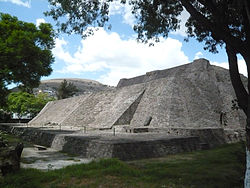Tenayuca (Mexico)
| Tenayuca pyramid | |
|---|---|
 Tenayuca pyramid |
|
| Data | |
| place | San Bartolo Tenayuca |
| Architectural style | Aztec |
| Floor space | 3120 m² |
| Coordinates | 19 ° 31 '55.8 " N , 99 ° 10' 6.5" W |
| particularities | |
| First pyramid with double temple in Latin America | |
 Valley of Mexico before the Spanish conquest |
|
Tenayuca ( Nahuatl : "Brick Square" ) is a pre-Columbian city in the Valley of Mexico . The facility, located today in San Bartolo Tenayuca ( State of Mexico ), 10 km north of central Mexico City , is considered to be the first capital of the Chichimecs .
history
Excavations carried out in Tenayuca indicate that the city was already settled in the classical period and, especially after the destruction of the Toltec Tula, was able to expand its importance as a supra-regional power center of the formerly nomadic Chichimecs .
In the historical tradition of the Chichimecs, the city was founded around 1224 AD by the god of lightning, Xolotl . He was followed by Nopaltzin , who was able to consolidate and expand the power of the Chichimean empire. After the son of Nopaltzin Tlotzin died, his successor Quinatzin relocated the center of power of the Chichimean Empire to Texcoco and Tenayuca lost its importance as a result.
It is certain that at the end of the 13th century the ruler of Tenayuca, Tochintecuhtli , allied himself with Huetzin , the leader of the Acolhulas of Catlichàn , and was able to bring the valley of Mexico under his suzerainty. Mid-14th century Tenayuca was from the rival city of Azcapotzalco conquered, and finally in 1434 under the rule of from Tenochtitlan originating Aztecs arrive.
During the course of the Spanish conquest of Mexico at the beginning of the 16th century, the city was finally captured after a short battle in 1520 and, due to its architecture, was described by the conquistador Bernal Díaz del Castillo as the "city of snakes".
During the first excavations by Mexican archaeologists in 1925, the abandonment of the city as a result of the Spanish conquest was proven.
Building the pyramid
The central pyramid of Tenayuca is characterized by a broad masonry base, from which a double staircase leads to the temples of the Aztec gods Tlaloc and Huitzilopochtli on the top of the pyramid. On the side walls of the pyramid there are a total of 138 snake sculptures, which used to be brightly painted. Striking on this "wall of snakes" ( Nahuatl : "coatepantli" ) are two coiled snakes on the north and south side, which are provided with symbols of the fire snake Xiuhcoatl and which, like all snake figures in the complex, for the worship of Fire and sun stand.
Similar to other Mesoamerican pyramid structures, the complex was generously expanded by repeated overbuilding and received its present appearance at the beginning of the 16th century by Aztec builders. The central double pyramid is also the oldest double pyramid in Mexico. Its unique architectural style with two temples on the top of the pyramid was modeled after the city was conquered in the middle of the 15th century in temples such as Tlatelolco and the Templo Mayor in Tenochtitlan.
In the vicinity of the pyramid there are a number of shrines or altars which were also designed with snake motifs. Two hundred meters from the main pyramid, foundations and mosaics of buildings that are believed to have been inhabited by the local elites have been excavated.
The research and management of the facility is guaranteed by the Instituto Nacional de Antropología e Historia .
Picture gallery
See also
swell
- Davis, Nigel, The Aztecs; Master of State Art, Creator of High Culture, Rororo, Reinbek bei Hamburg, 1976, 438 pp., ISBN 3499169509 , ISBN 9783499169502
- Riese, Berthold, The Empire of the Aztecs; History and Culture, Munich, 2011, 431 pp.
- Excavation history and historical development of Tenayuca (span.)
- Short report about the system (span.)
proof
- ↑ http://www.inah.gob.mx/zonas/137-zona-arqueologica-tenayuca-iy-ii
- ↑ Davies, pp. 165f.
- ↑ http://www.tlalnepantla.gob.mx/archivohistorico/4zona_tenayuca.asp
- ↑ Riese pp. 165-168







